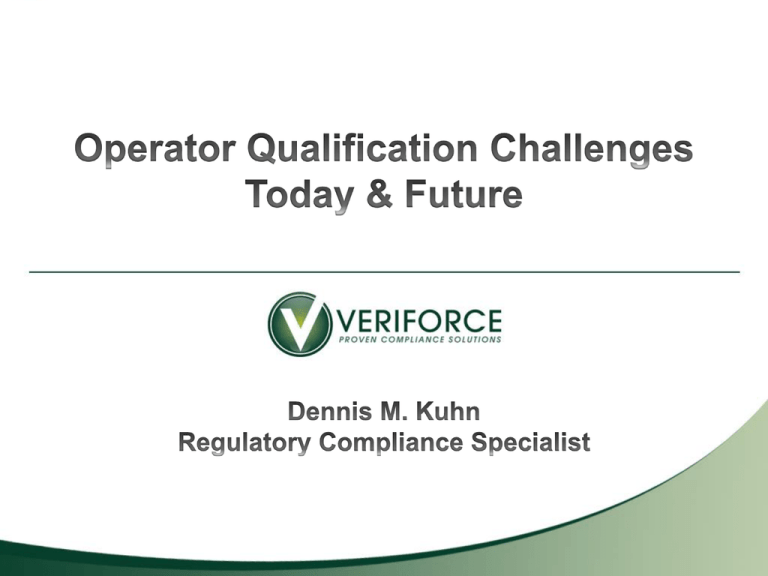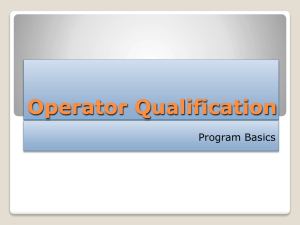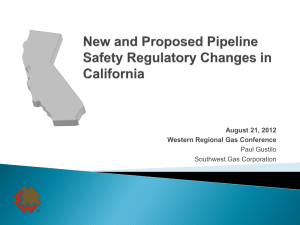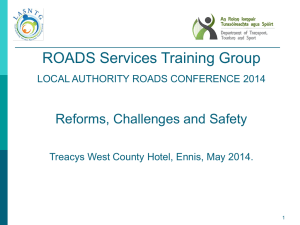Operator Qualification (OQ) Rule - Western Regional Gas Conference
advertisement

Introduction OQ Addressing abnormal operating conditions during evaluations and at job site Tracking OQ during major projects Maintaining records of who actually performed the covered task(s) Span of Control limitations and documentation Addressing the “gaps” between: Qualification and Operator-specific procedures Performing OQ work and meeting D&A requirements Recent regulatory OQ findings and expectations Q&A The OQ Rule is intended to provide an additional level of safety and requires pipeline Operators to develop a qualification program to evaluate an individual’s ability to perform covered tasks and to recognize and react to abnormal operating conditions that may occur while performing covered tasks. OQ is not intended to be a one-time event, but a process that continues for the working lifetime of an individual. After initial evaluation and qualification have been completed, re-evaluation and requalification is required. The Operator must recognize this and designate for each covered task an appropriate time interval for requalification. Why do we need qualified individuals… A KC-135 aircraft was being pressurized at ground level. The outflow valves which are used to regulate the pressure of the aircraft were capped off during a 5 year overhaul and never opened back up. Abnormal operating condition means a condition identified by the operator that may indicate a malfunction of a component or deviation from normal operations that may: (a) Indicate a condition exceeding design limits; or (b) Result in a hazard(s) to persons, property, or the environment. Qualified individuals must be able to recognize and react appropriately to AOC’s. Recognize: means that the employees are able to identify a situation or event on the pipeline that is out of the ordinary and could become a hazard to the public or environment, if not promptly corrected. React appropriately: means the employee knows what to do to ensure that the hazard is promptly addressed. This could include notifying the employee’s supervisor or site inspector or taking the correct action to mitigate the hazard, whichever is appropriate for the AOC. Task-specific versus generic PHMSA OQ FAQ - Operators are expected to develop a thorough listing of AOCs, both task-specific and generic. The task-specific AOCs may be included within the evaluation criteria for the specific task, but the generic AOCs should be maintained in a separate list and reviewed periodically. PHMSA Integrated Inspection Guidance - In addition to task-specific AOCs (i.e., those that may be caused by performance of the task), generic AOCs (i.e., those that may reasonably be encountered during performance of the task) have been identified and used in qualification in cases where special requirements and conditions for the task being performed must be considered. During evaluation At the job site Identify applicable covered tasks for the activities that will be performed Communicate requirements to all affected personnel Assure personnel are qualified to perform the applicable covered tasks, before they perform the task Addressing Span of Control (SOC) Obtain/maintain qualification records No one can perform a covered task unless they are specifically qualified to perform that task or are directed, observed and supervised by a qualified individual (if span of control is allowed) as outlined in the OQ plan Sample Covered Task List A SOC ratio of 1:3 would mean that one qualified employee could direct and observe up to three unqualified employees. Assure that a qualified person is always present during activities where a covered task is being performed Assure that all individuals, qualified and non-qualified, understand the requirements Consider any conditions that may impact the SOC ratio, such as: Language Barriers Noise Level Weather Regulatory agencies’ expectations “Sniper” Observations Track personnel who actually performed Need to identify individual for each covered task Inspectors’ role? How often do you verify qualifications and identities? Who worked under SOC? Record Discussions AOC’s (Site-Specific) SOC limits & adjustments Procedures/policies task(s) Task criteria versus Operator Use of “off-the-shelf” covered tasks procedures How is it addressed? Need to demonstrate that the person in the “ditch” is aware of procedures Best Practices Tailgate meetings JSA’s Training Regulatory agencies’ expectations 49 CFR Part 199 outlines the requirements for Operators including contractors and subcontractors. Operators of pipeline facilities that are subject to part 192, 193, or 195, are required to test covered employees for the presence of prohibited drugs and alcohol. Operators are responsible for meeting 49 CFR parts 40 and 199 to include but not limited to: All actions of your officials, reps, and agents (including service agents) in carrying out the requirements of the DOT agency regulations. Maintain and follow a written Anti-Drug & Alcohol Misuse Prevention Plan that conforms to the requirements Assure that all covered employees are aware of the provisions and coverage of the plan Provide clear policies and provisions for education and training, drug and alcohol testing Provide when needed, referral for evaluation, education, and treatment to employees Contractor compliance The OQ Rule is intended to provide an additional level of safety and requires pipeline Operators to develop a qualification program to evaluate an individual’s ability to perform covered tasks and to recognize and react to abnormal operating conditions that may occur while performing covered tasks. Drugs and alcohol effect a person’s ability to make coherent decisions, motor functions and vision. Thus drugs and alcohol effect an individual’s ability to perform covered tasks and to recognize and react to abnormal operating conditions that may occur while performing covered tasks. D&A and OQ Cannot perform covered work until compliance with D&A are met How is it monitored? Need to demonstrate that the person(s) (Internal and Contractors) meet D&A, prior to performing covered work D&A Program Challenges Program Monitoring TPA Contractor Compliance State laws Medical marijuana Recreational use Medical Marijuana States Currently there are 19 States that have approved the use of Medical Marijuana State vs. Federal Medical use and or State legalized use of controlled substances CFR 49 parts 40 and 199 = Federal requirement No State can authorize violations of federal law Addressing D&A-OQ “Gap” Need to periodically review program Need to develop method for contractor compliance When was the last review? Are you using a TPA? Review Contractor D&A Plans for compliance Monitor statistical data How do you assure contractors that do not meet compliance are not performing covered functions? Need to communicate non compliance of contractors to field personnel Who is Responsible Like OQ, the Operator is held responsible for noncompliance Internal Plan Contractor Plan Third Party Administrator The Pipeline Enforcement Program has a number of different mechanisms to assure operator compliance and safe operation. Including: • • • • • • Letters of Concern Warning Letters Notice of Amendment Notice of Probable Violations Corrective Action Orders Notice of Proposed Safety Order The Pipeline Safety, Regulatory Certainty, and Job Creation Act of 2011 increased the civil penalty authority of PHMSA to a maximum of $200,000 per violation per day, up to a maximum of $2,000,000 for a related series of violations. 2002 – June 2013 • Corrective Action Orders 102 • Notice of Probably Violation 738 • Notices of Amendment 877 • Warning Letters 727 • Notices of Proposed Safety Orders 13 • Civil Penalties 541 Proposed Penalties $54,301,200 Assessed Penalties $37,735,437 (Including 33 cases in 2013)) Criminal penalties may be taken: If any person willfully and knowingly violates a pipeline safety requirement is subject to a fine of not more than $25,000 for each offense, imprisonment for not more than five years, or both. If any person willfully violates a regulation for off-shore gathering lines is subject to a fine of not more than $25,000 for each offense, imprisonment for not more than five years, or both. If any person willfully and knowingly injures or destroy any interstate pipeline facility, is subject to a fine of not more than $25,000 for each offense, imprisonment for not more than 15 years, or both. If any person willfully and knowingly defaces, damages, removes, or destroys any pipeline sign, right-of-way marker, or marine buoy, that individual is subject to a fine of not more than $5000 for each offense, imprisonment not to exceed one year, or both. OQ Protocol Summary Statistics Significant Protocol Areas Potential Issues /Overall Inspections % PI 4.02 Abnormal Operating Conditions (AOCs) 2116 / 5998 35.3 3.01 Documentation for Individual on CTs 2018 / 5998 33.6 8.02 Notification of Program Changes 1130 / 3563 31.7 2.02 Evaluation Methods for KSA’s 1895 / 5998 31.6 7.01 Qualification Trail 1880 / 5998 31.3 2009 – Operator failed to identify a covered task (hot tap) nor had anyone properly qualified: $100,000 fine assessed 2009 – Operator failed to identify a covered task (threaded fitting assembly: $133,100 fine assessed (being contested) 2010 – Operator did not enforce SOC properly: $100,000 fine assessed (being contested) 2010 – Operator allowed unqualified personnel to perform covered tasks; $271,300 fine assessed (being contested) 2010 – Operator failed to identify a covered task (mud plugs) nor had anyone properly qualified: $788,000 fine assessed 2010 – Operator failed to identify covered tasks nor had properly qualify personnel: $98,600 fine assessed Operator did not have “on-site” supervisory personnel who were provided the 60-minute training regarding identification of probable drug use. The interim area manager is trained but is only “on-site” approximately once every 3 months. Operators anti-drug plan procedures were found inadequate by PHMSA. Did not include accident definitions Post accident drug testing procedures did not explicitly define which employees are covered by Company’s anti-drug plan. A civil penalty of $40,000 for Operators violation of 49 C.F.R.§ 199.225(a)(1), for failing to test each covered employee for alcohol whose performance of a covered function either contributed to the May 4, 2009 accident or could not be completely discounted as a contributing factor to that accident. Required annual testing percentages not met DAMIS Reporting No data to report (contractor compliance Operator failed to identify contractors whom performed covered work Flooding the pool Plan does not meet the minimum requirements Laboratory not approved DER not understanding regulations/requirements Drug/Alcohol Plans outdated Missing data or inaccurate Post-accident testing not meeting regulations/requirements Rehabilitation process/procedures not followed Testing statistics not maintained or submitted Records not maintained or available On the horizon: New construction and inspection tasks may be included Activities based on incorporated references Expansion of pipeline facilities Routine monthly break-out tank inspections All gathering lines Well heads Underground storage facilities Verification of contractor knowledge of Operator procedures Documentation of qualified individual that actually performed the task (who wrapped that pipe, etc.)








